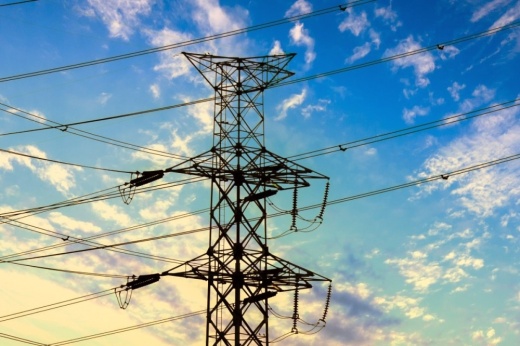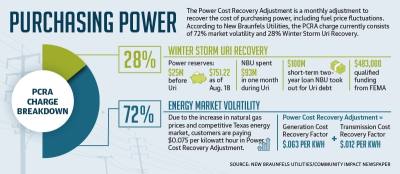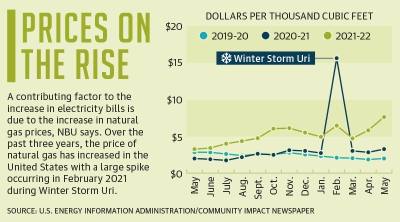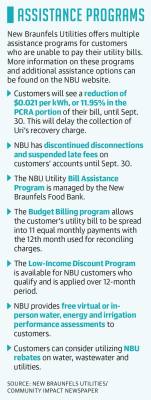Customers of New Braunfels Utilities have seen high charges on their electricity bills this summer, causing widespread concern of how they will be able to keep up with increasing monthly payments.
A 39% increase in overall electricity bill costs in July 2022 compared to July 2021 was seen by the average utility customer, who utilizes about 1,800 kilowatt hours per month. kWh is a measure of how much energy is being used per hour.
According to NBU, customers’ electric bills are increased this summer due to extreme and prolonged heat in the region, an increase in the cost of power due to natural gas prices rising and regulatory changes made to the Electric Reliability Council of Texas electric market following Winter Storm Uri.
The Power Cost Recovery Adjustment increased by 127% this July compared to the previous year for the average NBU customer. The PCRA is the portion of the NBU utility bill that reflects the cost to buy energy from ERCOT. Because the cost of purchasing power from the energy market fluctuates, so do the charges reflected on the PCRA.
NBU stated that as a not-for-profit entity, only actual costs are charged and not marked up for profit. ••NBU officials also cite inflation, supply chain issues and effects on the global energy market caused by the war in Ukraine as contributing to high natural gas prices. According to NBU, the utility also saw a 32% increase in electricity usage by customers in July of this year compared to July 2021 due to the dry and hot summer Central Texas is experiencing.
“It’s been a difficult summer for NBU customers. There’s been some anger, frustration and certainly some worry about high utility bills from what we’re experiencing this summer,” NBU CEO Ian Taylor said.
An estimated 28% of the PCRA will go toward rebuilding NBU’s reserves following debt incurred during Winter Storm Uri, with customers paying $0.024 per kilowatt-hour. The remaining 72% of the PCRA is attributed to energy market volatility—a charge of $0.054 per kWh.
“The way to think of the PCRA is that it is a commodity market where we are buying our electricity from. And because it’s a commodity market, there’s volatility,” Taylor said. “So the PCRA is simply something that goes up and down to cover the volatility in the market. So there’s the base rate plus the PCRA. We take those two together, that is the total cost of electricity.”
The variable cost of generation and transmission rates are what make up the PCRA, according to NBU. Transmission rates are determined by ERCOT once a year, while the generation rates are more variable based on the energy costs in the ERCOT market. The generation rates include the remainder cost for buying power that is not covered by the base rate electricity charge on customer’s bills, NBU Chief Administrative Officer David Hubbard said.
“Our cost of energy has increased to the point where our base rates are no longer set appropriately enough to recover the full cost that we need for the cost of energy. And that’s why the PCRA rate is now higher than the base rate,” Hubbard said.
Regina Manfredi, a New Braunfels resident of 17 years, said she began researching the PCRA charge after watching it rise on her utility bills over the past several months. Manfredi has spoken at several NBU meetings and passed out a petition signed by over 6,000 NBU customers to City Council members during an Aug. 8 New Braunfels City Council meeting.
“I think it is important that [NBU customers] understand what that PCRA is comprised of today. And that is loan payback, cost overruns and cash reserve efforts,” Manfredi said. “And those are the three things that ..., if that’s what’s going to drive the PCRA, NBU leadership has allowed for it to get incredibly out of hand. And we need to go look in those three areas together as a community to say, ‘All right, what can we fix?’”
Debt from Uri
During Winter Storm Uri in February 2021, NBU incurred costs of $93 million due to the high demand and cost of energy. According to Hubbard, the company only had 30 days to pay back the cost of the winter storm. Because of this, all of the money in the power reserves and contingency reserves was used to cover those debts. Additionally, a two-year $100 million loan was taken out by NBU to cover the cost, according to Melissa Krause, chief strategic communications and security officer for NBU.
Krause said $50 million of the loan was used toward the remaining debt from Uri, and the other $50 million was placed in an emergency reserve until NBU is able to build back its reserves. Prior to the winter storm, NBU had $25 million in power reserves funding. As of Aug. 19, the utility company has $751.22, according to Hubbard.
Taylor said the NBU board of trustees opted to pursue the short-term loan because the power supply program worked well during Uri, resulting in less debt than other utility companies.
“So the total liability we had coming out of it was low enough that it made sense to do short-term debt. So again we saved $44 million [in interest], and that is a lot of money by doing that instead of a 30-year bond,” Taylor said.
NBU officials said they have collected the money necessary to pay off the $100 million loan but have not made the full payment yet. $15 million of the loan was paid in June 2022, and the utility company plans to pay off the remaining $35 million when the loan payment is due in March 2023.
The utility company did qualify for $483,000 of funding from the Federal Emergency Management Agency following 2021’s winter storm to go toward physical assets that were damaged but has received $30,000 of the funding so far.
NBU plans to replenish the reserves over a period of eight years. Additionally, it has shifted the reserve policy from 90 days of funding saved to 365 days of funding in the reserves.
“The reason it moved from the number of [90] days is because during February of 2021, we spent a year’s worth of power costs in a single month. And so that’s why we went to 365 days because that’s the potential risk of cost,” said Rebekah Crouch, power supply manager at NBU.
According to the July report by Fitch Ratings, a bond rating agency that analyzes the stability of a company’s financial metrics, NBU purchases the majority of its power through short-term contracts, which may expose the utility company to significantly higher operating costs in the event of a volatile energy market.
NBU was exposed to both day-ahead and real-time prices at ERCOT’s price cap of $9,000 per megawatt-hour and up to $25,000 per mWh for ancillary services, or the services necessary to support the transmission of electric power from generators to consumers, during Uri. MWh equals 1,000 kilowatts of electricity generated per hour and is used to measure electric output.
ERCOT instability
NBU receives its power from ERCOT through a financial hedging program that finds ways to offset the cost of power a day ahead in the real-time energy markets. A hedging program is a risk management strategy used to counteract losses in investments.
According to Hubbard, the goal of the electric grid prior to Uri was to achieve the lowest cost of power possible for utility companies that purchase power. But since the storm, the goal of ERCOT has now shifted to provide reliability to the state so the power grid does not fail.
“Historically the day ahead and real-time market, when we’re looking at energy contracts, they are typically the lowest cost form of power you can buy. Unfortunately, that low-cost power comes with huge risks,” Hubbard said. “Because it’s also the most volatile type of power you can buy. Because the price, especially let’s say in real time, the price is shifting every 15 minutes depending on supply and demand in the market.”
Due to the shift in the energy market, NBU officials said they are evaluating what they can do to provide competitive costs to customers. Purchasing power longer term or owning generation assets like a power generation plant are among the options they are considering.
According to the Summer 2022 Electricity Industry Outlook published by the U.S. Energy Information Administration, higher-than-expected natural gas prices, along with the limited responsiveness of coal generation, led to increases in both wholesale and retail electricity prices this summer.
In May 2021, the Texas Natural Gas Industrial Price was $3.27 per thousand cubic feet, while in May 2022 natural gas prices reached $7.64 per MCF. MCF is the US market standard measurement for natural gas volume, according to the EIA. While Texas produces natural gas domestically, Taylor said it is traded on the international market, which ultimately determines its price.
“The cost of natural gas, which is up not just in Texas, but across the country from what’s going on in Ukraine and other impacts,” Taylor said. “That’s driving prices up and then on top of that for the last about a year and a half the Public Utility Commission of Texas has been making changes to the ERCOT market and redesigning ERCOT markets to prioritize reliability over price.”
Customer support
Due to the response from NBU customers, the utility company has reduced a portion of the PCRA charge from Aug. 1-Oct. 31. A reduction of $0.021 per kWh will be made in the PCRA portion of the bill, which represents an 11.95% reduction to the electric portion of the bill. The adjustment will delay the collection of Uri’s recovery funding, according to NBU.
The PCRA charge will still appear on customer bills as the Uri recovery costs are collected. NBU representatives said they are empathetic to the effects of rising costs on customers and are working to mitigate the high prices. The temporary adjustment is intended to allow costs to be spread out over the fall and winter months when electric usage decreases, according to NBU.
“There is not one person on this board, not one person that works for NBU that does not care about this city,” NBU Trustee Yvette Villanueva Barrera said. “And we know you guys don’t feel it. But this board is doing everything they can to work with NBU and to work with the city so that we can provide some relief for you guys.”
The PCRA charge will remain on customers’ utility bills for the foreseeable future, but NBU officials anticipate the charge will decrease as high summer temperatures abate.
According to NBU, the Public Utility Commission of Texas is prioritizing reliability over price as it makes changes to the ERCOT market after Uri. The changes have resulted in higher electricity prices that are not expected to decrease to pre-February 2021 levels.
“We do not control the cost of power and our costs. So as that power changes, that PCRA rate changes to reflect that. It’s similar to going to a gas station; you know that rate is variable depending on what that commodity cost. That’s the same thing with the PCRA is capturing that variable cost,” NBU Chief Financial Officer Dawn Schriewer said.









